Orthodontics
Early Treatment
Although a dentist trained in orthodontics can enhance a smile at any age, there is an optimal time period to begin treatment. Beginning treatment at this time ensures the greatest result and the least amount of time and expense. The Australian Dental Association recommends that the initial orthodontic evaluation should occur at the first sign of orthodontic problems or no later than age 7. At this early age, orthodontic treatment may not be necessary, but vigilant examination can anticipate the most advantageous time to begin treatment.
Early evaluation provides both timely detection of problems and greater opportunity for more effective treatment. Prudent intervention guides growth and development, preventing serious problems later. When orthodontic intervention is not necessary, a dentist trained in orthodontics can carefully monitor growth and development and begin treatment when it is ideal.
Some of the most direct results of interceptive treatment are:
• Creating room for crowded, erupting teeth
• Creating facial symmetry through influencing jaw growth
• Reducing the risk of trauma to protruding front teeth
• Preserving space for unerupted teeth
• Reducing the need for tooth removal
• Reducing treatment time with braces
Adult Treatment
Braces aren't just for kids anymore. Tooth alignment can be changed at any age if your gums and bone structure are healthy. We offer a variety of treatments that are designed for different age groups - including adults. A new smile can begin today.
Orthodontic treatment at later stages in life can dramatically improve your personal appearance and self-esteem. Improving the health of your teeth and gums is equally important. Crooked teeth and a bad bite can contribute to gum and bone loss, tooth decay, abnormal wear of the tooth enamel and surfaces, headaches and jaw joint pain.
Why Straighten Teeth?
People have orthodontic treatment to improve the appearance, health and function of their teeth. • Appearance
People are very aware of how teeth look and an attractive smile can play an important role in enhancing self-confidence. These days, with good oral hygiene and regular dental care, your teeth should last a lifetime - wouldn't it be nice if they looked good too?
• Hygiene
It's more difficult to clean your teeth when they are crowded and overlapping. Inadequate cleaning is a major factor in tooth decay, gum disease and eventual tooth loss. Whilst it is possible to keep even the most crooked teeth clean, having your teeth straightened will make it easier for you to look after them.
• Tooth Wear
It is claimed that some bad bites lead to clenching, grinding, and excessive wear and/or uneven wear of the teeth.
• Gum Damage
In severe malocclusions the teeth can damage the gum. For example, in cases of deep bite, the lower front teeth can bite into the gum behind the upper front teeth.
• Jaw Joint Problems
It is claimed that some bad bites stress the jaw joint causing damage and pain in and around the joint.
• Speech
Some people have difficulty speaking properly because of alignment problems with their teeth and jaws.
What is Orthodontics?
Orthodontics is that branch of dentistry which specialises in the diagnosis, prevention and treatment of problems in the alignment of teeth and jaws.
The technical term for these problems is malocclusion, which literally means bad bite.
Orthodontic treatment involves the design and use of corrective appliances (such as braces, plates, headgears and functional appliances) to bring the teeth and jaws into proper alignment.
Types of Malocclusion (Click to Enlarge)
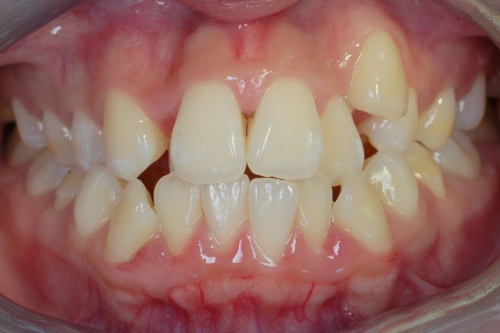 Crowding |
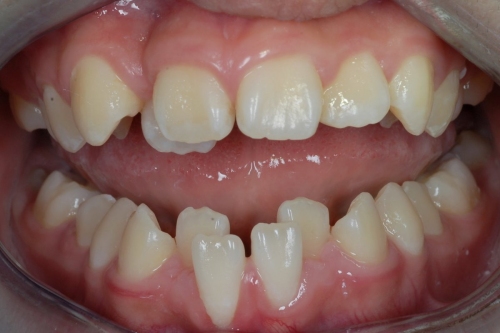 Crowding |
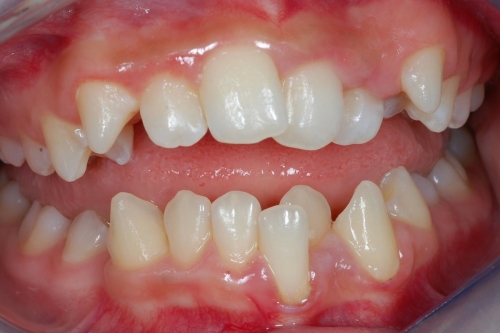 Crowding |
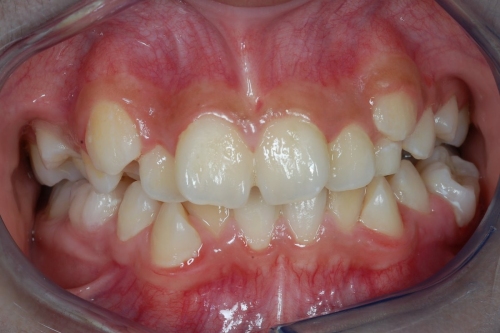 Crowding |
 Crowding |
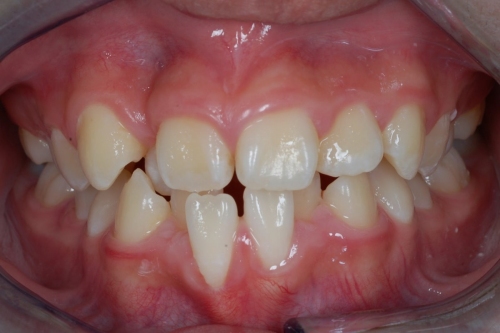 Crowding |
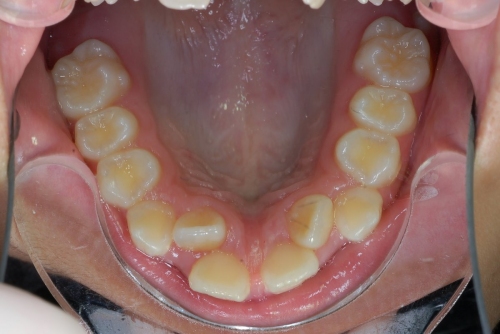 Crowding |
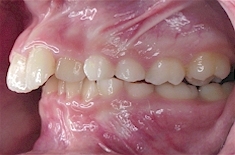 Protruded Teeth |
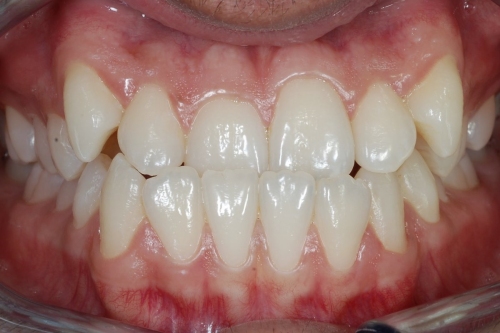 Under Bite |
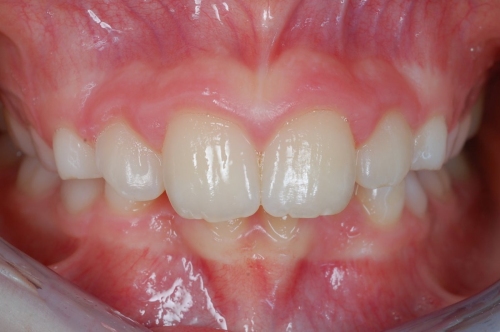 Deep Bite |
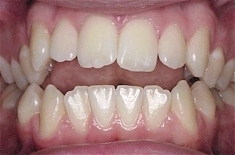 Open Bite |
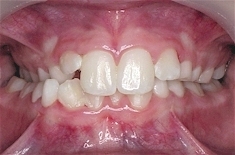 Cross Bite |
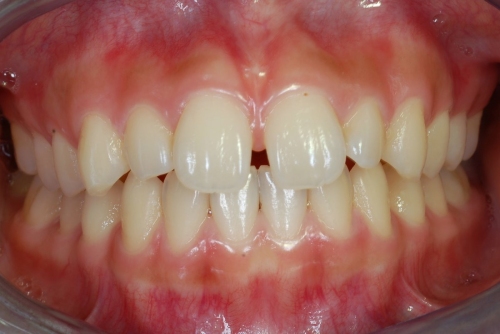 Spacing |
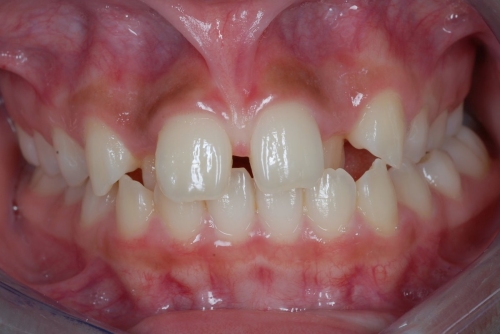 Spacing |
 Peg Shaped Laterals |
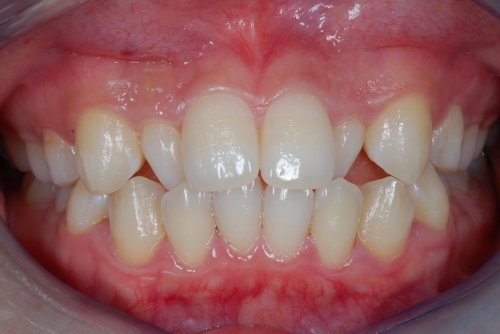 Peg Shaped Laterals |
Early Treatment
Although a dentist trained in orthodontics can enhance a smile at any age, there is an optimal time period to begin treatment. Beginning treatment at this time ensures the greatest result and the least amount of time and expense. The Australian Dental Association recommends that the initial orthodontic evaluation should occur at the first sign of orthodontic problems or no later than age 7. At this early age, orthodontic treatment may not be necessary, but vigilant examination can anticipate the most advantageous time to begin treatment.
Early evaluation provides both timely detection of problems and greater opportunity for more effective treatment. Prudent intervention guides growth and development, preventing serious problems later. When orthodontic intervention is not necessary, a dentist trained in orthodontics can carefully monitor growth and development and begin treatment when it is ideal.
Some of the most direct results of interceptive treatment are:
• Creating room for crowded, erupting teeth
• Creating facial symmetry through influencing jaw growth
• Reducing the risk of trauma to protruding front teeth
• Preserving space for unerupted teeth
• Reducing the need for tooth removal
• Reducing treatment time with braces
Adult Treatment
Braces aren't just for kids anymore. Tooth alignment can be changed at any age if your gums and bone structure are healthy. We offer a variety of treatments that are designed for different age groups - including adults. A new smile can begin today.
Orthodontic treatment at later stages in life can dramatically improve your personal appearance and self-esteem. Improving the health of your teeth and gums is equally important. Crooked teeth and a bad bite can contribute to gum and bone loss, tooth decay, abnormal wear of the tooth enamel and surfaces, headaches and jaw joint pain.
Why Straighten Teeth?
People have orthodontic treatment to improve the appearance, health and function of their teeth. • Appearance
People are very aware of how teeth look and an attractive smile can play an important role in enhancing self-confidence. These days, with good oral hygiene and regular dental care, your teeth should last a lifetime - wouldn't it be nice if they looked good too?
• Hygiene
It's more difficult to clean your teeth when they are crowded and overlapping. Inadequate cleaning is a major factor in tooth decay, gum disease and eventual tooth loss. Whilst it is possible to keep even the most crooked teeth clean, having your teeth straightened will make it easier for you to look after them.
• Tooth Wear
It is claimed that some bad bites lead to clenching, grinding, and excessive wear and/or uneven wear of the teeth.
• Gum Damage
In severe malocclusions the teeth can damage the gum. For example, in cases of deep bite, the lower front teeth can bite into the gum behind the upper front teeth.
• Jaw Joint Problems
It is claimed that some bad bites stress the jaw joint causing damage and pain in and around the joint.
• Speech
Some people have difficulty speaking properly because of alignment problems with their teeth and jaws.








